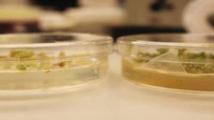Summary
Methionine, up to 10−3 M, added to a basal medium enhanced bacterial ethylene production in 14 of the 20 bacteria tested. The effects of substrate, cofactors, light, and temperature on ethylene production byPseudomonas solanacearum #25 revealed that the greatest effect occurred when 10−5 M methionine and 10−4 M FMN were combined, from which 4.10μl/l of ethylene were produced. Higher levels of methionine resulted in production of high levels of non-enzymically produced ethylene and death of the bacteria. This non-enzymic production of ethylene was eliminated in the dark. Copper had no effect upon ethylene production. Twenty-nine and 35°C were inhibitory, whereas 19°C appeared to be near optimum for ethylene production.Pseudomonas solanacaerum #25 and some other bacteria are capable of ethylene production and methionine and FMN enhance this production.
Similar content being viewed by others
References
Bailey, W. R. and Scott, E. G. 1966 Diagonostic Microbiology. The C.V. Mosby Company, St. Louis, Mo., p. 329.
Burg, S. P. 1962 The physiology of ethylene formation. Annu. Rev. Plant Physiol.13, 265–302.
Burg, S. P. and Thimann, K. V. 1959 The physiology of ethyiene formation in apples. P.N.A.S.45, 335–344.
Edney, K. L. 1967 The development ofBotrytis cinerea on cut flowers of carnation. Ann. Appl. Biol.60, 367–374.
Freebairn, H. T. and Buddenhagen, I. W. 1964 Ethylene production byPseudomonas solanacearum. Nature London202, 313–314.
Goeschl, J. D., Rappaport, L. and Pratt, H. K. 1966 Ethylene as a factor regulating the growth of pea epicotyls subjected to physical stress. Plant Physiol.41,877–884.
Hansen, E. 1942 Quantitative study of ethylene production in relation to respiration of pears. Bot. Gaz.103, 543–559.
Ilag, L. and Curtis, R. W. 1968 Production of ethylene by fungi. Science159, 1357–1358.
Kato, Y. and Uritani, I. 1972 Ethylene biosynthesis in diseased sweet potato root tissue with special reference to the methionine system. Agric. Biol. Chem. Vol.36, 13, 2601–2604.
Lund, B. M. 1973 The effect of certain bacteria on ethylene production by plant tissue.In Fungal Pathogenicity and the Plants Response. Ed. by R. J. W. Byrde and C. V. Cutting. Academic Press, N.Y.
Lund, B. M. and Mapson, L. W. 1970 Stimulation byErwinia caratovora of the synthesis of ethylene in cauliflower tissue. Biochem. J.119, 251–263.
Mapson, L. W. and Wardale, D. A. 1967 Biosynthesis of ethylene: formation of ethylene from methional by a cell-free enzyme system from cauliflower florets. Biochem J.102, 572–585.
Murr, D. P. and Yamp, S. F. 1975 Inhibition of in vivo conversion of methionine to ethylene by L-Canaline and 2,4-Dinitrophenol. Plant Physiol.55, 79–82.
Paterson, D. R., Lyle, E. W. and Earhart, D. R. 1975 Crown gall and ethylene content of rose plants. Hort. Sci.10, 381.
Patil, S. S. and Tam, L. Q. 1972 Mode of action of the toxin fromPseudomonas phaseolicola. I. Toxin specificity, chlorosis, and ornithine accumulation. Plant Physiol.49, 803–807.
Primrose, S. B. 1976 Ethylene-forming bacteria from soil and water. J. Gen. Microbiology97, 343–346.
Primrose, S. B. 1976 Formation of ethylene byEscherichia coli. J. Gen. Microbiol.95, 159–165.
Primrose, S. B. and Dilworth, M. J. 1976 Ethylene production by bacteria. J. Gen. Microbiology93, 177–181.
Radin, J. W. and Loomis, R. S. 1969 Ethylene and carbon dioxide in the growth and development of cultured radish roots. Plant Physiol.44, 1584–1589.
Staby, C. L. and DeHertogh, A. A. 1970 The detection of ethylene in the internal atmosphere of bulbs. Hort. Science5, 399–400.
Williamson, C. E. 1950 Ethylene, a metabolic product of diseased or injured plants. Phytopathology40, 205–208.
Yang, S. F. 1967 Biosynthesis of ethylene—ethylene formation from methional by horseradish peroxidase. Arch. Biochem. Biophys.122, 481–487.
Yang, S. F., Ku, H. S. and Pratt, H. K. 1967 Photochemical production of ethylene from methionine and its analogues in the presence of flavin mononucleotide. J. Biol. Chem.242, 5274–5280.
Author information
Authors and Affiliations
Additional information
This work was supported by the Fred C. Gloeckner Foundation and the University of Minnesota Graduate School Grant in Aid #496-0307-4909-02.
Rights and permissions
About this article
Cite this article
Swanson, B.T., Wilkins, H.F. & Kennedy, B.W. Factors affecting ethylene production by some plant pathogenic bacteria. Plant Soil 51, 19–26 (1979). https://doi.org/10.1007/BF02205923
Received:
Revised:
Issue Date:
DOI: https://doi.org/10.1007/BF02205923




